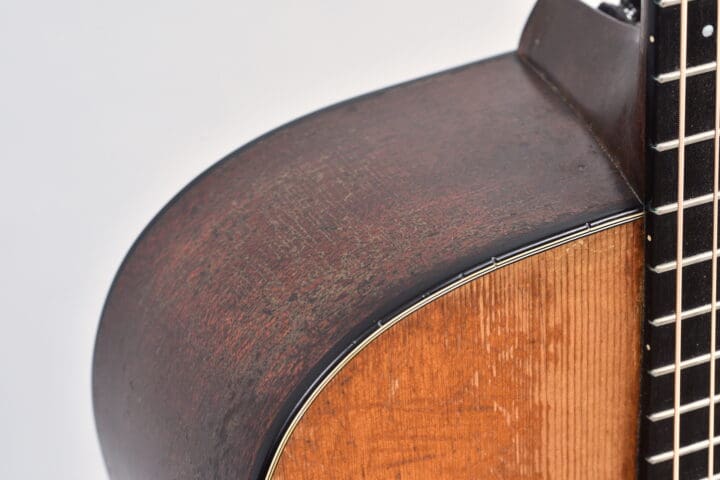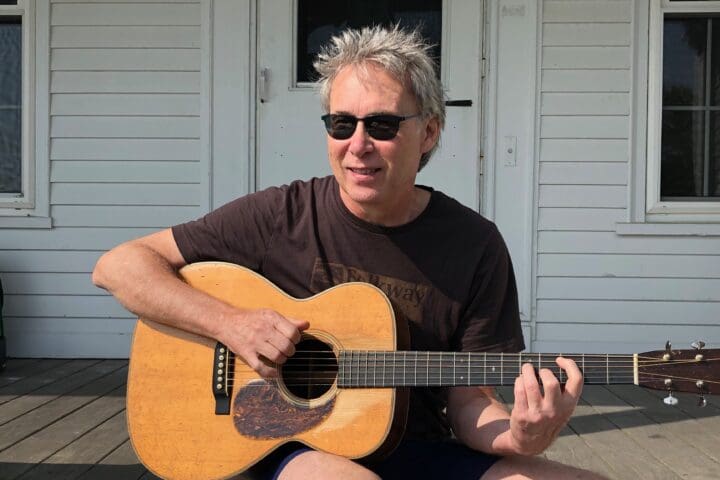1932 Martin C-2 Converted to OM-28
Today’s Catch started life as a C-2, a roundhole archtop that Martin made in 1931 and 1932. Martin’s archtops were a hybrid design, with the back and sides of a flattop and a carved top. This particular way of building produced a guitar that was neither fish nor fowl. They didn’t have the punch and power of a guitar with a carved back and they didn’t have the sustain and warmth of a flattop. Consequently they never found a constituency among players and when Martin discontinued archtops during Wold War II I suspect no one really noticed. The situation hasn’t changed too much these days and Martin archtops are not in particularly high demand. Unless, for some reason, a top on one of them has been damaged beyond repair. Then a luthier can, in good conscience, salvage the neck, sides and back and convert the guitar into a flattop, which is what happened here.
Mark Stutman at Folkway Music got his hands on a 1932 C-2 with a caved-in top. He decided that since the sides and back were in good shape, and made from some gorgeous Brazilian rosewood, that this guitar should live out the rest of its life as an OM-28. Converting a C-2 is a tricky proposition. Although the body size is the same as an OM, in its C-2 configuration the neck is set back at a very steep angle to accommodate the arched top and tall bridge. If you want to reuse the original neck and fretboard you need to reshape the part of the heel that contacts the body to get back to a shallower neck angle. This winds up moving the fingerboard very slightly forward, which means the neck joins the body somewhere between the 13th and 14th frets. This in turn means that the bridge has to be positioned a little further from the soundhole than it would be on an original OM. On the other hand, this also allows the luthier to properly intonate the bridge and make a guitar that plays in better tune than an original 1930s Martin.
If you want the feel of an old guitar, it makes sense to go to all this work. Like an OM, the C-2 had a long, 25.4-inch scale length, which this converted OM also has. The neck has a nice, rounded V-shape and bar stock frets, which I think feel great it they are properly set up. The original headstock overlay was damaged so Stutman had inlay artist Mark Kett make new pearl letters for it. The new top is made of Adirondack spruce and the braces were patterned on a 1929 OM. This type of conversion is tricky to pull off but from the photos it looks like Mark Stutman did a great job of taking a dead guitar and bringing it back to life in way that makes it better than new. It’s currently priced at $12,500, a fraction of the price of an original OM and cheaper than comparably built new guitar made of Brazilian rosewood.
Click here to see the original listing.
This 1932 C-2/OM-28 comes with its original case.
It doesn’t really show up in this photo but the back of the C-2 had a very slight arch in it. This was done by bending the back with some extra heavy back braces. I’ve played a couple of converted guitars similar to this over the years and this doesn’t seem to affect the tone much one way or the other.

The original Grover tuning machines.

Stutman did an excellent job reshaping the heel. If you weren’t told the work had been done, it would be almost impossible to tell.

If you peek in the soundhole you can see this used to be a C-2.
Mark Kett did a fine job cutting out these letters. Although he does use modern CNC technology on some of his modern inlays, when he’s recreating an old design like this he prefers to work by hand.
The bracing for this top was patterned after a 1929 OM. Note that it has the small maple bridgeplate.

James Cagney playing his roundhole C-2. No, that is not the guitar Mark Stutman re-topped.



